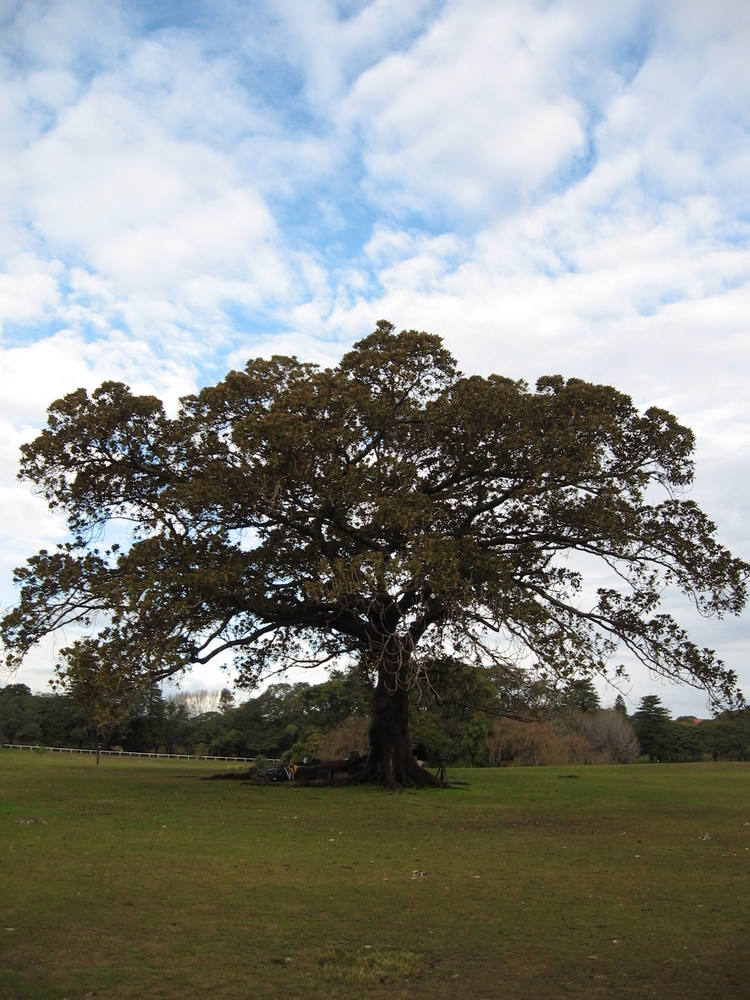Fig Tree Biography
The Moreton Bay Fig is an evergreen tree that can reach heights of 60 m (200 ft).[1] The trunk can be massive, with thick, prominent buttressing, and reach a diameter of 2.4 m (8 ft).[3] The rough bark is grey-brown,[10] and marked with various blemishes.[11] It is monoecious: each tree bears functional male and female flowers.[4] As implied by its specific epithet, it has large, elliptic, leathery, dark green leaves, 15–30 cm (6–12 in) long, and they are arranged alternately on the stems. The leaves and branches bleed a milky sap if cut or broken. The figs are 2–2.5 cm (0.75–1 in) in diameter, turning from green to purple with lighter spots as they ripen;[1] ripe fruit may be found year round,[11] although more abundant from February to May.[3] Although edible, they are unpalatable and dry
The characteristic "melting" appearance of the Moreton Bay fig is due to its habit of dropping aerial roots from its branches, which upon reaching the ground, thicken into supplementary trunks which help to support the weight of its crown.
It is a rainforest plant and in this environment more often grows in the form of an epiphytic strangler vine than that of a tree. When its seeds land in the branch of a host tree it sends aerial, 'strangler' roots down the host trunk, eventually killing the host and standing alone.
Its roots are surface feeding and it is quite susceptible to earth compaction around its trunk, which is why in many locations these trees are fenced. It is water-hungry, and like many Australian trees should neither be planted in urban environments where its roots may damage piping, nor where water is scarce.
The Moreton Bay Fig is an evergreen tree that can reach heights of 60 m (200 ft).[1] The trunk can be massive, with thick, prominent buttressing, and reach a diameter of 2.4 m (8 ft).[3] The rough bark is grey-brown,[10] and marked with various blemishes.[11] It is monoecious: each tree bears functional male and female flowers.[4] As implied by its specific epithet, it has large, elliptic, leathery, dark green leaves, 15–30 cm (6–12 in) long, and they are arranged alternately on the stems. The leaves and branches bleed a milky sap if cut or broken. The figs are 2–2.5 cm (0.75–1 in) in diameter, turning from green to purple with lighter spots as they ripen;[1] ripe fruit may be found year round,[11] although more abundant from February to May.[3] Although edible, they are unpalatable and dry
The characteristic "melting" appearance of the Moreton Bay fig is due to its habit of dropping aerial roots from its branches, which upon reaching the ground, thicken into supplementary trunks which help to support the weight of its crown.
It is a rainforest plant and in this environment more often grows in the form of an epiphytic strangler vine than that of a tree. When its seeds land in the branch of a host tree it sends aerial, 'strangler' roots down the host trunk, eventually killing the host and standing alone.
Its roots are surface feeding and it is quite susceptible to earth compaction around its trunk, which is why in many locations these trees are fenced. It is water-hungry, and like many Australian trees should neither be planted in urban environments where its roots may damage piping, nor where water is scarce.
Fig Tree
Fig Tree
Fig Tree
Fig Tree
Fig Tree
Fig Tree
Fig Tree
Fig Tree
Fig Tree
Fig Tree Propagation - Part 1








No comments:
Post a Comment